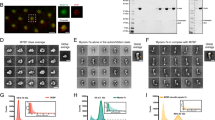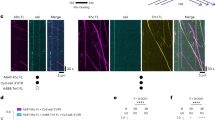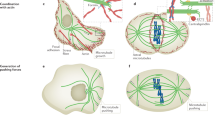Abstract
Proper spindle positioning and orientation are essential for asymmetric cell division and require microtubule–actin filament (F-actin) interactions in many systems1,2. Such interactions are particularly important in meiosis3, where they mediate nuclear anchoring4,5,6, as well as meiotic spindle assembly and rotation7,8, two processes required for asymmetric cell division. Myosin-10 proteins are phosphoinositide-binding9, actin-based motors that contain carboxy-terminal MyTH4 and FERM domains of unknown function10. Here we show that Xenopus laevis myosin-10 (Myo10) associates with microtubules in vitro and in vivo, and is concentrated at the point where the meiotic spindle contacts the F-actin-rich cortex. Microtubule association is mediated by the MyTH4-FERM domains, which bind directly to purified microtubules. Disruption of Myo10 function disrupts nuclear anchoring, spindle assembly and spindle–F-actin association. Thus, this myosin has a novel and critically important role during meiosis in integrating the F-actin and microtubule cytoskeletons.
This is a preview of subscription content, access via your institution
Access options
Subscribe to this journal
Receive 51 print issues and online access
$199.00 per year
only $3.90 per issue
Buy this article
- Purchase on Springer Link
- Instant access to full article PDF
Prices may be subject to local taxes which are calculated during checkout




Similar content being viewed by others
References
Gundersen, G. G. & Bretscher, A. Cell biology. Microtubule asymmetry. Science 300, 2040–2041 (2003)
Rodriguez, O. C. et al. Conserved microtubule–actin interactions in cell movement and morphogenesis. Nature Cell Biol. 5, 599–609 (2003)
Sardet, C., Prodon, F., Dumollard, R., Chang, P. & Chenevert, J. Structure and function of the egg cortex from oogenesis through fertilization. Dev. Biol. 241, 1–23 (2002)
Lessman, C. A. Germinal vesicle migration and dissolution in Rana pipiens oocytes: effect of steroids and microtubule poisons. Cell Differ. 20, 239–251 (1987)
Gard, D. L. Ectopic spindle assembly during maturation of Xenopus oocytes: evidence for functional polarization of the oocyte cortex. Dev. Biol. 159, 298–310 (1993)
Alexandre, H., Van Cauwenberge, A. & Mulnard, J. Involvement of microtubules and microfilaments in the control of the nuclear movement during maturation of mouse oocyte. Dev. Biol. 136, 311–320 (1989)
Gard, D. L., Cha, B. J. & Roeder, A. D. F-actin is required for spindle anchoring and rotation in Xenopus oocytes: a re-examination of the effects of cytochalasin B on oocyte maturation. Zygote 3, 17–26 (1995)
Sun, Q. Y. et al. Dynamic events are differently mediated by microfilaments, microtubules, and mitogen-activated protein kinase during porcine oocyte maturation and fertilization in vitro. Biol. Reprod. 64, 879–889 (2001)
Isakoff, S. J. et al. Identification and analysis of PH domain-containing targets of phosphatidylinositol 3-kinase using a novel in vivo assay in yeast. EMBO J. 17, 5374–5387 (1998)
Berg, J. S., Derfler, B. H., Pennisi, C. M., Corey, D. P. & Cheney, R. E. Myosin-X, a novel myosin with pleckstrin homology domains, associates with regions of dynamic actin. J. Cell Sci. 113, 3439–3451 (2000)
Kim, N.-H. et al. The distribution and requirements of microtubules and microfilaments in bovine oocytes during in vitro maturation. Zygote 8, 25–32 (2000)
Shimizu, T. Polar body formation in Tubifex eggs. Ann. NY Acad. Sci. 582, 260–272 (1990)
Sardet, C., Speksnijder, J., Terasaki, M. & Chang, P. Polarity of the ascidian egg cortex before fertilization. Development 115, 221–237 (1992)
Sokac, A. M. & Bement, W. M. Regulation and expression of metazoan unconventional myosins. Int. Rev. Cytol. 200, 197–304 (2000)
Narasimhulu, S. B. & Reddy, A. S. N. Characterization of microtubule binding domains in the Arabidopsis kinesin-like calmodulin binding protein. Plant Cell 10, 957–965 (1998)
Rogers, S. L. et al. Regulation of melanosome movement in the cell cycle by reversible association with myosin V. J. Cell Biol. 146, 1265–1276 (1999)
Cox, D. et al. Myosin-X is a downstream effector of PI(3)K during phagocytosis. Nature Cell Biol. 4, 469–477 (2002)
Gard, D. L. Organization, nucleation, and acetylation of microtubules in Xenopus laevis oocytes: a study by confocal immunofluorescence microscopy. Dev. Biol. 143, 346–362 (1991)
Yonezawa, S. et al. Possible involvement of myosin-X in intercellular adhesion: importance of serial pleckstrin homology regions for intracellular localization. Dev. Growth Differ. 45, 175–185 (2003)
Homma, K., Saito, J., Ikebe, R. & Ikebe, M. Motor function and regulation of myosin X. J. Biol. Chem. 276, 34348–34354 (2001)
Tokuo, H. & Ikebe, M. Myosin-X transports Mena/VASP to the tip of filapodia. Biochem. Biophys. Res. Commun. 319, 214–220 (2004)
Weil, D. et al. Defective myosin VIIA gene responsible for Usher syndrome type 1B. Nature 374, 60–61 (1995)
Wolfrum, U., Liu, X., Schmitt, A., Udovichenko, I. P. & Williams, D. S. Myosin VIIa as a common component of cilia and microvilli. Cell. Motil. Cytoskeleton 40, 261–271 (1998)
Lantz, V. A. & Miller, K. G. A class VI unconventional myosin is associated with a homologue of a microtubule-binding protein, cytoplasmic linker protein-170, in neurons and at the posterior pole of Drosophila embryos. J. Cell Biol. 140, 897–910 (1998)
Huang, J. D. et al. Direct interaction of microtubule- and actin-based transport motors. Nature 397, 267–270 (1999)
Cao, T. T., Chang, W., Masters, S. E. & Mooseker, M. S. Myosin-Va binds to and mechanochemically couples microtubules to actin filaments. Mol. Biol. Cell 15, 151–161 (2004)
Sokac, A. M., Co, C., Taunton, J. & Bement, W. Cdc42-dependent actin polymerization during compensatory endocytosis in Xenopus eggs. Nature Cell Biol. 5, 727–732 (2003)
Mandato, C. A. & Bement, W. M. Actomyosin transports microtubules and microtubules control actomyosin recruitment during Xenopus oocyte wound healing. Curr. Biol. 13, 1096–1105 (2003)
Weber, K. L. & Bement, W. M. F-actin serves as a template for cytokeratin organization in cell free extracts. J. Cell Sci. 115, 1373–1382 (2002)
Bement, W. M., Hasson, T., Wirth, J. A., Cheney, R. E. & Mooseker, M. S. Identification and overlapping expression of multiple unconventional myosin genes in vertebrate cell types. Proc. Natl Acad. Sci. USA 91, 6549–6553 (1994)
Acknowledgements
Thanks to G. Von Dassow and J. Canman for critical reading of this manuscript. This work was supported by grants from the National Institutes of Health to W.M.B. and R.E.C.
Author information
Authors and Affiliations
Corresponding author
Ethics declarations
Competing interests
The authors declare that they have no competing financial interests.
Supplementary information
Supplementary Fig. S1
Complete amino acid sequence of XlMyo10. (DOC 21 kb)
Supplementary Fig. S2
Immunocolocalization of XlMyo10 is F-actin independent and specific. (JPG 34 kb)
Supplementary Fig. S3
Microtubule association of MyTH4-FERM constructs is F-actin independent. (JPG 22 kb)
Supplementary Fig. S4
Purification of GST-4F. (JPG 12 kb)
Supplementary Fig. S5
GFP-PH4F expression does not depolymerize microtubules. (JPG 70 kb)
Supplementary Fig. S6
GFP-PH4F targets to spindles. (JPG 19 kb)
Supplementary Fig. S7
GFP-PH4F disrupts meiotic spindle assembly. (JPG 36 kb)
Rights and permissions
About this article
Cite this article
Weber, K., Sokac, A., Berg, J. et al. A microtubule-binding myosin required for nuclear anchoring and spindle assembly. Nature 431, 325–329 (2004). https://doi.org/10.1038/nature02834
Received:
Accepted:
Issue Date:
DOI: https://doi.org/10.1038/nature02834
This article is cited by
-
Cell-particles interaction – selective uptake and transport of microdiamonds
Communications Biology (2024)
-
Follicular fluid C3a-peptide promotes oocyte maturation through F-actin aggregation
BMC Biology (2023)
-
A dual functional Ti-Ga alloy: inhibiting biofilm formation and osteoclastogenesis differentiation via disturbing iron metabolism
Biomaterials Research (2023)
-
Phenotypic analysis of Myo10 knockout (Myo10tm2/tm2) mice lacking full-length (motorized) but not brain-specific headless myosin X
Scientific Reports (2019)
-
The role of polarisation of circulating tumour cells in cancer metastasis
Cellular and Molecular Life Sciences (2019)
Comments
By submitting a comment you agree to abide by our Terms and Community Guidelines. If you find something abusive or that does not comply with our terms or guidelines please flag it as inappropriate.



